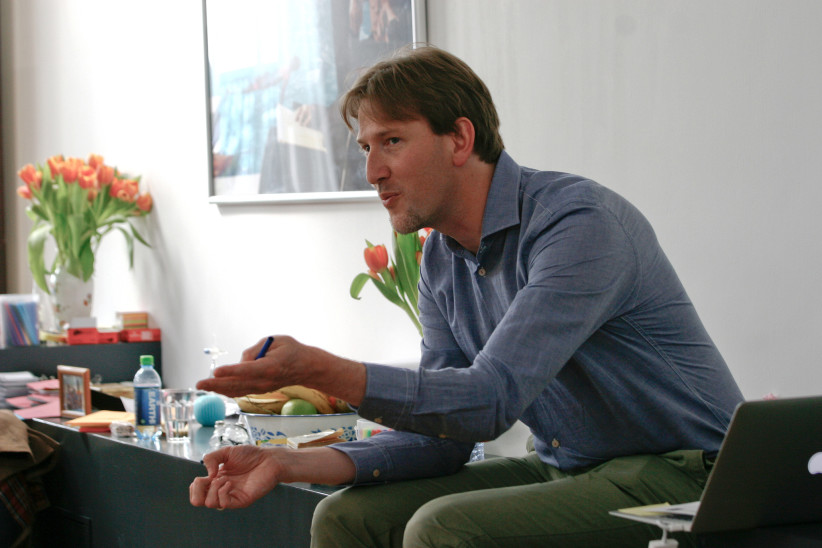Why we need craftsmanship in the field of labs
Along with Kennisland, process facilitator and advisor in social innovation Remko Berkhout visited LabWorks, a conference about labs, for labs. These are his insightful takeaways, a valuable read for anyone working in the field of social innovation labs.
Building a new world in the shell of the old, but how?
A snapshot of the evening news: refugee chaos, IS, piecemeal progress on climate negotiations. It’s astounding how our existing institutional frameworks are failing us. How ‘a little less worse’ has become the new good. How, in an age of abundance, we seem to be stuck in an age of endings? And it seems that it’s not just the politicians, bureaucrats and business moguls that are failing but the entire web of our collective life. It must be possible to do better. Yes we can! But how to build a new world in the shell of the old?
Questions like these are at the heart of a fast growing global phenomenon called ‘social innovation labs’. They come in many shapes and sizes. One common denominator is their ambition to break through the status quo and to do so by offering space for experiments and new connections. The Danish Mindlab explores new governance mechanisms for the 21st century. The Finance Innovation Lab attempts to transform the global finance system. Ushahidi’s I-hub in Nairobi is the heart of East Africa’s booming ‘tech for change’ scene. MITs game lab, Rockefellers I-teams, Chile’s ‘Laboratorio de Gobierno’, the list goes on. Have a look for yourself at the growing body of literature, networks, emerging critiques++Lab MattersRead Kennisland’s publication Lab Matters., toolboxes and lab-maps. In our co-authored book ‘Labcraft’++LabcraftKennisland participated in a booksprint that led to co-authoring Labcraft with twelve international lab colleagues. , some of the world’s more seasoned labs present first-hand account of their stories and approaches.
The narrative of labs comes with grand claims and an adventurous spirit. My interest is how that translates into a practice. If my own lab practice is anything to go by: it’s messy and erratic. Nesta’s LabWorks conference offered an opportunity to step back. Inevitably, such gatherings veer towards the positive: successful case studies, new toolkits, eager funders. The struggles come out when the light fades and drinks are served. Here are a number of challengesIn an age of abundance, we seem to be stuck in an age of endings. I picked up from fellow lab practitioners during LabWorks++LabWorksLab gatherings are on the rise. Nesta’s LabWorks shows the field is growing extensively and claims to have organized ‘the largest gathering of labs as of yet’. Kennisland together with Hivos organized the first Lab of Labs (Lab2) in 2013. Mars Solutions Lab in Toronto followed up in 2014 with Labs for Systems Change..
Systemic ambitions
The lab lingo is spreading a lot faster than its substance. I was stunned to hear an Austrian mayor recently announcing living labs as the new standard for urban development. He then passed on the word to his urban planners who proceeded with the ‘we-know-best-hence-no-participation-necessary-thank-you-very-much’ speak. Cynics point out that labs are a perfect anti-politics machine. Much easier to control a tightly organized group working on your terms, than to deal with the claims of messy social movements. But even where intentions are sincere, resistance is part of the game. The search for new solutions, even when endorsed by high level policy makers is easily interpreted as a judgement of past performance at lower levels. The time and willingness to move beyond such initial positions to get to the real systemic stuff is often in short supply, while ambitions are high and results are needed fast.
Experimentation and emergence
Building trust and going slow are often at odds with an emergent approach to change and urge to experiment. Design thinkers tell us to think out of the box, to try, fail and then fail faster. That’s how we learn and innovate. But playful formats or failed experiments easily squander initial political commitment and stakeholder involvement.Playful formats or failed experiments easily squander initial political commitment and stakeholder involvement. It turns out too that working with emergence is, well, bloody hard work. You have to kill your darlings, build some kind of critical mass, manage expectations, and practice new techniques. Then there is all the stuff we have to unlearn. Because of our educational background, most of us are still shaking off the repertoires of the industrial age. At Labworks you could just hear it in the conversations: How can we ensure this? How can we scale that? Where’s the data? What are the tools? How to hit those targets? Questions without answers in conditions of complexity.
Back to the living world
We know too that a major barrier to institutional innovation is the growing gap between the systems world and the life world of citizens. The storyline is that we find new solutions out there, in the spaces where problems meet the lives of ordinary people. But that too implies resistance that often starts within your own core team. Why go to that busstation and talk with commuters when you can talk about them in meeting rooms? We can deal with the odd migrant organization, but surely you don’t want us to visit the Madrassah? Labs that start from bottom-up struggle to move beyond seeing government as a monolithic Kafkaesque entity. For most government labs, the citizenry remains a forest full of protestors and booby traps. It is easier to keep engagement at the surface and smother it in mapping studies, position papers, questionnaires and superficial gatherings. My biggest lesson: rationality reproduces the status quo.Rationality reproduces the status quo. The more adventurous stuff we try out such as social safaris, dialogue interviews and nature retreats always require more persuasion at the start.
An ecosystems approach to change
‘I must be doing something wrong’, you think, when a systems thinker like William Eggers points out that labs have to play an obvious role as a broker between problem solvers in innovation ecosystems. Nobody tells you how to find out how what that system looks like and how it works. ‘How the h… do systems gurus like Otto Scharmer consistently claim the ability to get it in one room then?’, you ask yourself subsequently. Mostly, the two-dimensional drawings that emerge on Google searches have very little to do with reality. Behind such silly pictures hides the real stuff: histories, cultures, power relations. Even if you eventually understand the gaps, breakdowns and possibilities, it’s far from obvious that your lab will be seen as a legitimate actor to step in. In any given system there is a critical mass of players caught in an equilibrium that sustains the status quo. Unless you bring a bag of money or high level political support, your interest in the system is not likely to be reciprocated, at least not in the short term.
Labcraft
Don’t get me wrong. I am a big believer in the potential of labs. We need more experiments. We need new combinations. We need, therefore, spaces where we can venture beyond our comfort zones. My point is that if we’re serious about the challenges we are taking on, we need to pay attention to developing a rigorous practice.If we’re serious about the challenges we are taking on, we need to pay attention to developing a rigorous practice. In this young field, there are only a handful of accounts of social labs that have documented their stories and processes++ChallengesCheck out Kennisland’s publication Lab Practice.. When you talk with experienced practitioners like Jennifer Morgan, the Kennisland crowd or Lena Hansen, you learn that they have faced similar conditions and found, through lots of trial and error, ways to navigate them. You start seeing that effective lab practice is a craft. It’s a craft that, among other things demands rigorous processes of self-development and an ability to understand which tools to use when. It also requires the ability to bridge discourses, world views and interests across a wide variety of stakeholders.
The question is what we are doingEffective lab practice is a craft. to nurture and capture this craft? Conferences, books and tool boxes are useful but not enough. If the transformative potential of labs lies in their ability to break through the status quo, perhaps we need to first apply such skills to our own learning processes. We need deeper learning and we probably need it fast: more exchange, apprenticeships, mentoring programmes, immersions, learning journeys. LabWorks drummed up generous support from the most ambitious of global funders. Surely they could spare a dime, if we come up with a solid plan. No, that’s the old world. Let’s rephrase: if we start experimenting right away!
Remko Berkhout supports global initiatives and organizations working on systemic social change. Working from Austria, he is currently supporting the development of social innovation labs on energy transitions, mobility and inclusive urban development. In 2014, he co-developed and edited Labcraft a book about lab practices, written by prominent social innovation practitioners from around the world. When working with Hivos, Remko organized the Wicked Series, Social Innovation Safari and Lab2 in collaboration with Kennisland.





